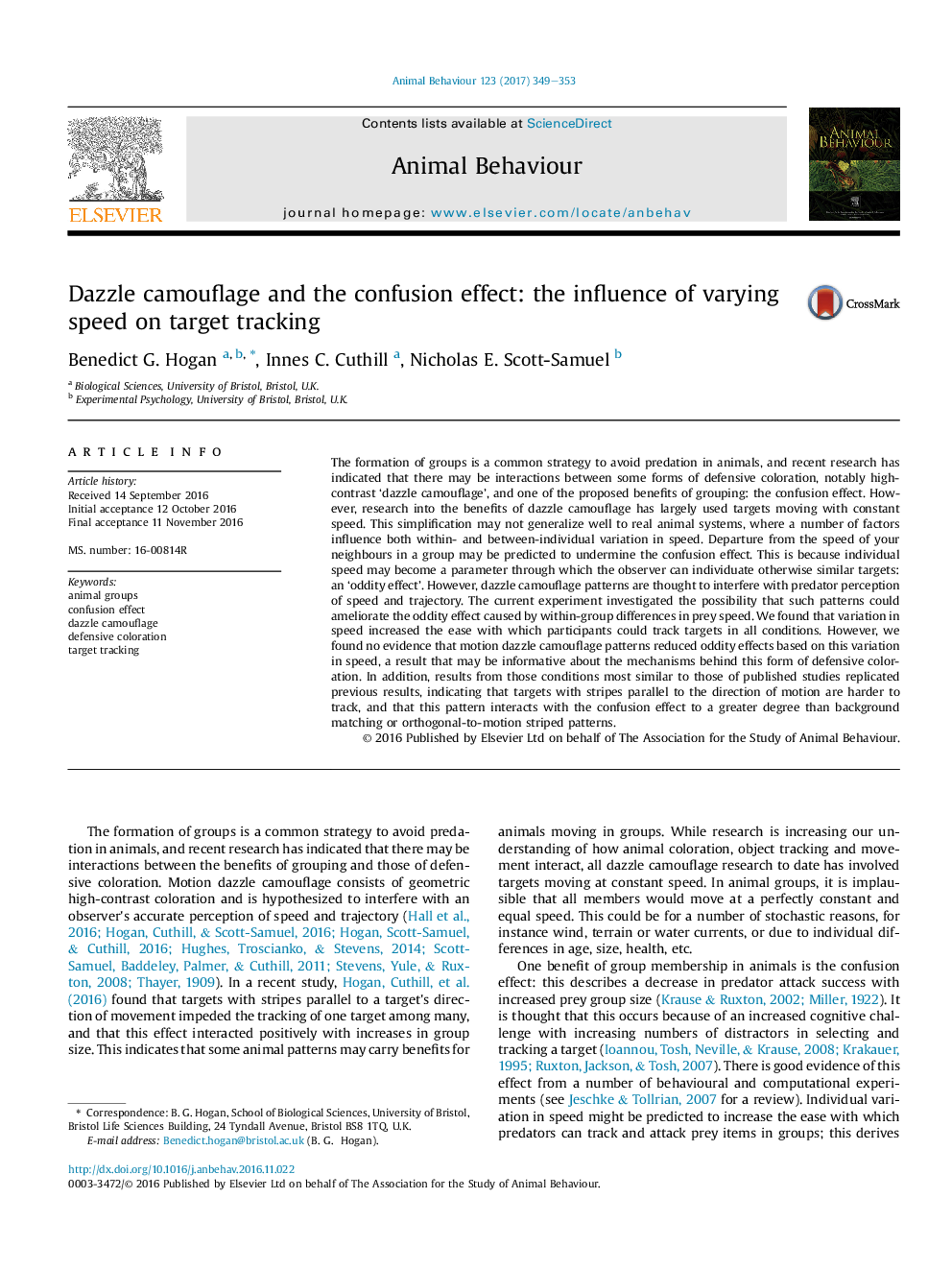| کد مقاله | کد نشریه | سال انتشار | مقاله انگلیسی | نسخه تمام متن |
|---|---|---|---|---|
| 5538599 | 1552205 | 2017 | 5 صفحه PDF | دانلود رایگان |
عنوان انگلیسی مقاله ISI
Dazzle camouflage and the confusion effect: the influence of varying speed on target tracking
ترجمه فارسی عنوان
استتار خیره کننده و اثر سردرگمی: تاثیر سرعت متغیر در ردیابی هدف
دانلود مقاله + سفارش ترجمه
دانلود مقاله ISI انگلیسی
رایگان برای ایرانیان
کلمات کلیدی
گروه های حیوانی، اثر سردرگمی استتار خیره کننده، رنگ آمیزی دفاعی، ردیابی هدف،
ترجمه چکیده
شکل گیری گروه ها یک استراتژی مشترک برای جلوگیری از شکار در حیوانات است و تحقیقات اخیر نشان داده اند که ممکن است تعاملات بین برخی از انواع رنگ دفاعی، خصوصا "استتار خیره کننده" با شدت کنتراست و یکی از مزایای پیشنهادی گروه بندی: اثر سردرگمی با این حال، تحقیق در مورد مزایای استتار خیره کننده تا حدود زیادی به اهداف حرکت با سرعت ثابت استفاده می شود. این ساده سازی ممکن است به سیستم های حقیقی حیوانات خوب تعمیم ندهد، در حالیکه تعدادی از عوامل بر تغییرات درون و درون فرد در سرعت تاثیر می گذارند. پیش بینی می شود خروج از سرعت همسایگان خود در یک گروه موجب تضعیف اثر سردرگمی شود. این به این دلیل است که سرعت شخصی ممکن است تبدیل به یک پارامتر شود که از طریق آن ناظر می تواند اهداف مشابه دیگری را در نظر بگیرد: یک اثر عجیب. با این حال، مدل های استتار خیره کننده فکر می کنند که با تصورات شکارچی از سرعت و مسیر مواجه می شوند. آزمایش کنونی احتمال این که الگوها می توانند تاثیر عجیب ناشی از تفاوت های درون گروهی در سرعت شکار را کاهش دهند، مورد بررسی قرار گرفت. ما دریافتیم که تغییرات در سرعت باعث افزایش سهولت می شود که شرکت کنندگان بتوانند در هر شرایطی اهداف را ردیابی کنند. با این حال، ما هیچ شواهدی را مبنی بر اینکه الگوهای استتار به حالت خیره کننده حرکت می کنند، تأثیرات عجیب و غریب را بر اساس این تغییرات در سرعت کاهش دادند، نتیجه ای که ممکن است در مورد مکانیزم های پشت این فرم رنگ دفاعی مفید باشد. علاوه بر این، نتایج از آن شرایط بیشتر شبیه به نتایج مطالعات منتشر شده، نتایج قبلی را تکرار می کنند، نشان می دهد که اهداف با نوارهای موازی با جهت حرکت سخت تر است و همچنین این الگو با تأثیر سردرگمی به میزان بالاتری نسبت به تطابق زمینه یا الگوهای خطی متعامد به حرکت.
موضوعات مرتبط
علوم زیستی و بیوفناوری
علوم کشاورزی و بیولوژیک
علوم دامی و جانورشناسی
چکیده انگلیسی
The formation of groups is a common strategy to avoid predation in animals, and recent research has indicated that there may be interactions between some forms of defensive coloration, notably high-contrast 'dazzle camouflage', and one of the proposed benefits of grouping: the confusion effect. However, research into the benefits of dazzle camouflage has largely used targets moving with constant speed. This simplification may not generalize well to real animal systems, where a number of factors influence both within- and between-individual variation in speed. Departure from the speed of your neighbours in a group may be predicted to undermine the confusion effect. This is because individual speed may become a parameter through which the observer can individuate otherwise similar targets: an 'oddity effect'. However, dazzle camouflage patterns are thought to interfere with predator perception of speed and trajectory. The current experiment investigated the possibility that such patterns could ameliorate the oddity effect caused by within-group differences in prey speed. We found that variation in speed increased the ease with which participants could track targets in all conditions. However, we found no evidence that motion dazzle camouflage patterns reduced oddity effects based on this variation in speed, a result that may be informative about the mechanisms behind this form of defensive coloration. In addition, results from those conditions most similar to those of published studies replicated previous results, indicating that targets with stripes parallel to the direction of motion are harder to track, and that this pattern interacts with the confusion effect to a greater degree than background matching or orthogonal-to-motion striped patterns.
ناشر
Database: Elsevier - ScienceDirect (ساینس دایرکت)
Journal: Animal Behaviour - Volume 123, January 2017, Pages 349-353
Journal: Animal Behaviour - Volume 123, January 2017, Pages 349-353
نویسندگان
Benedict G. Hogan, Innes C. Cuthill, Nicholas E. Scott-Samuel,
